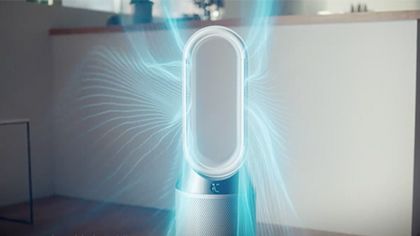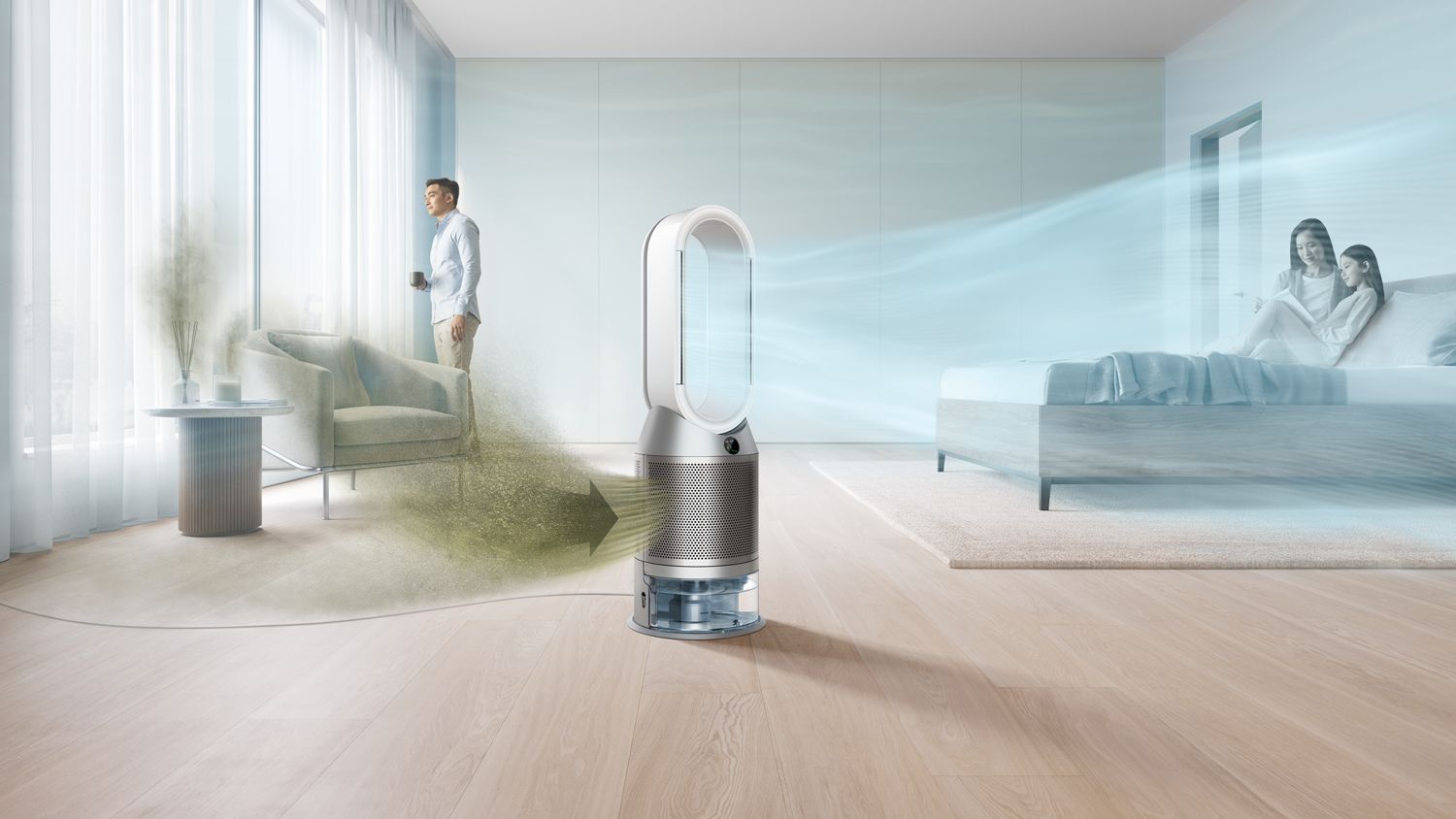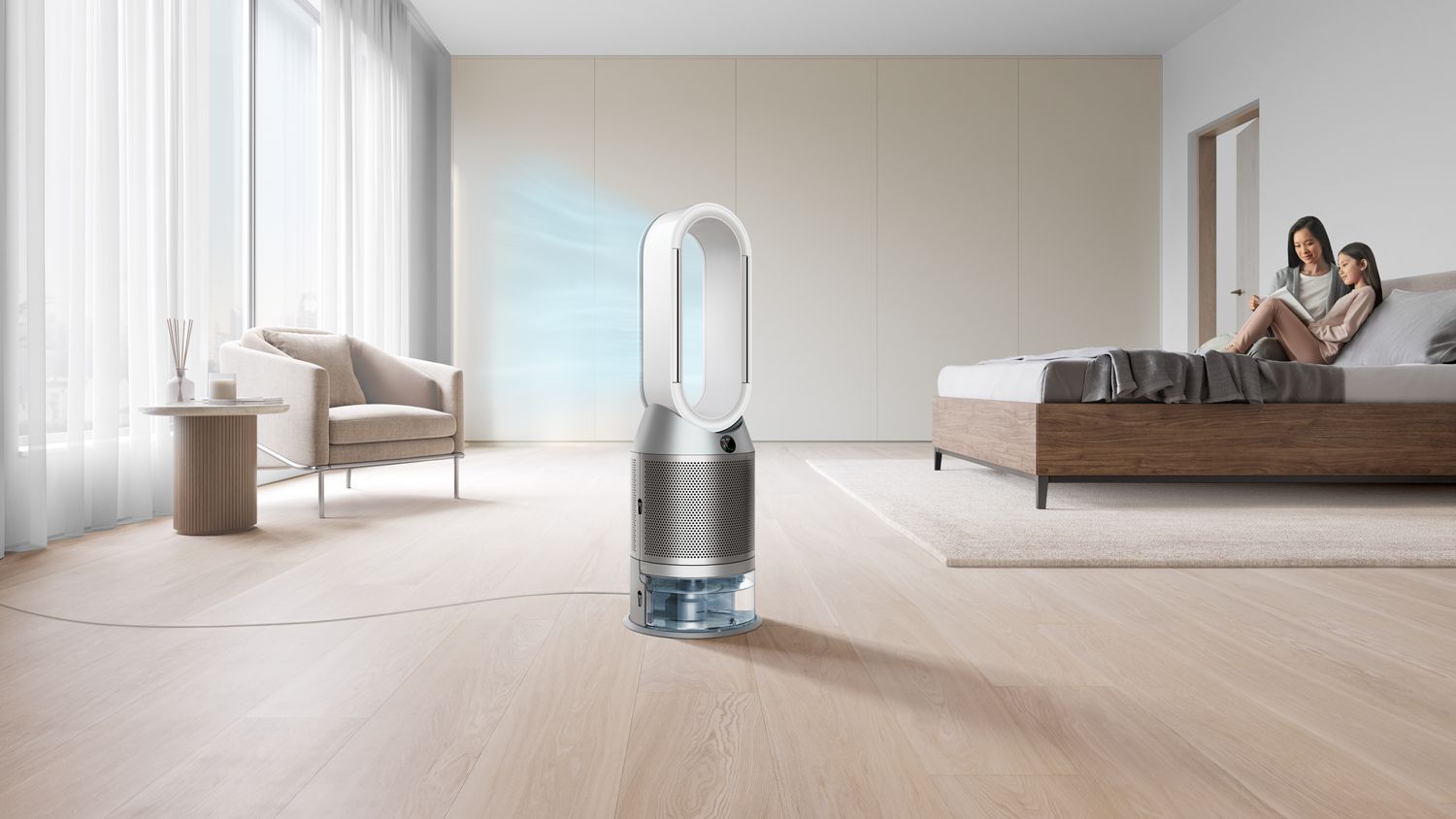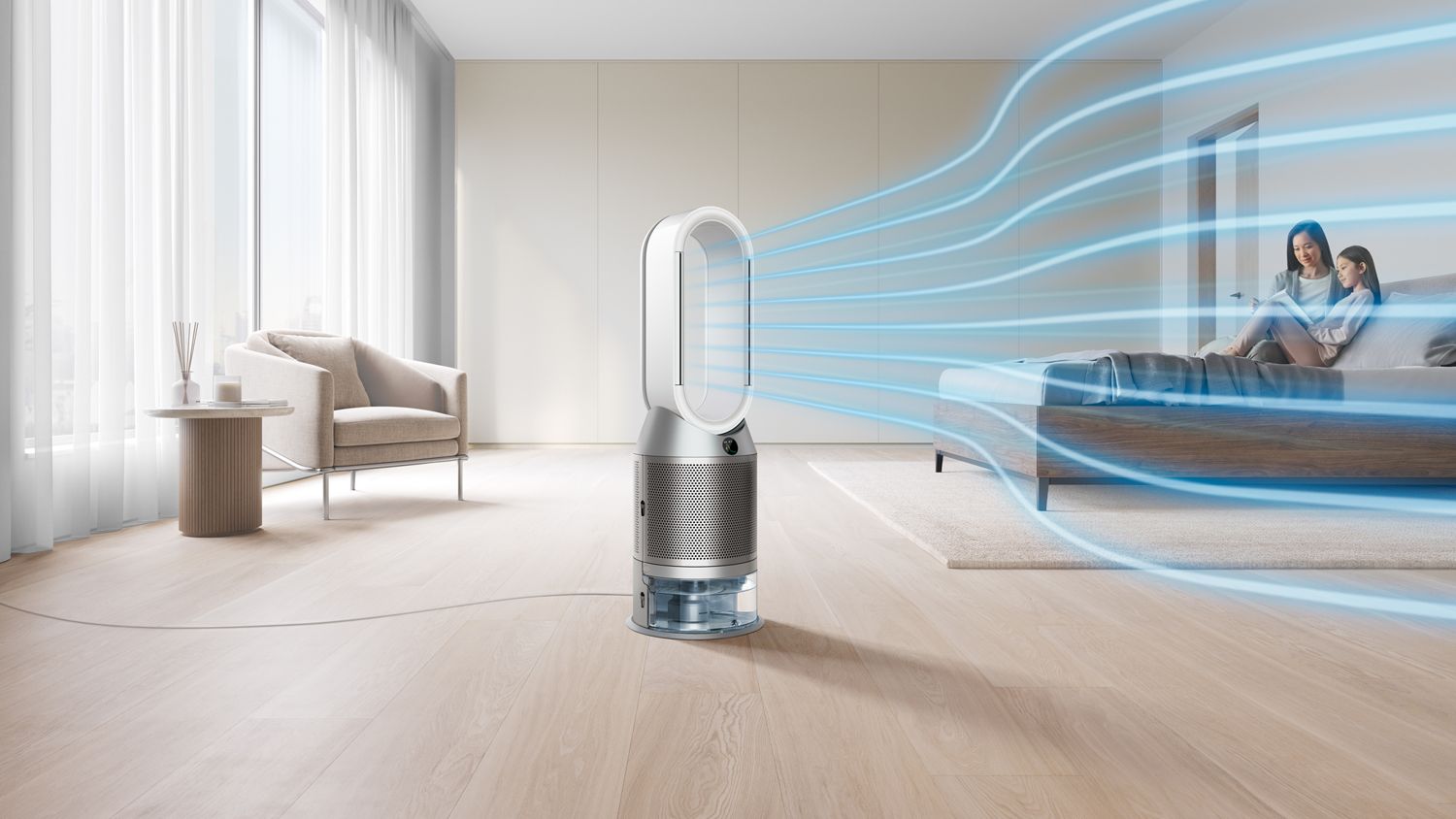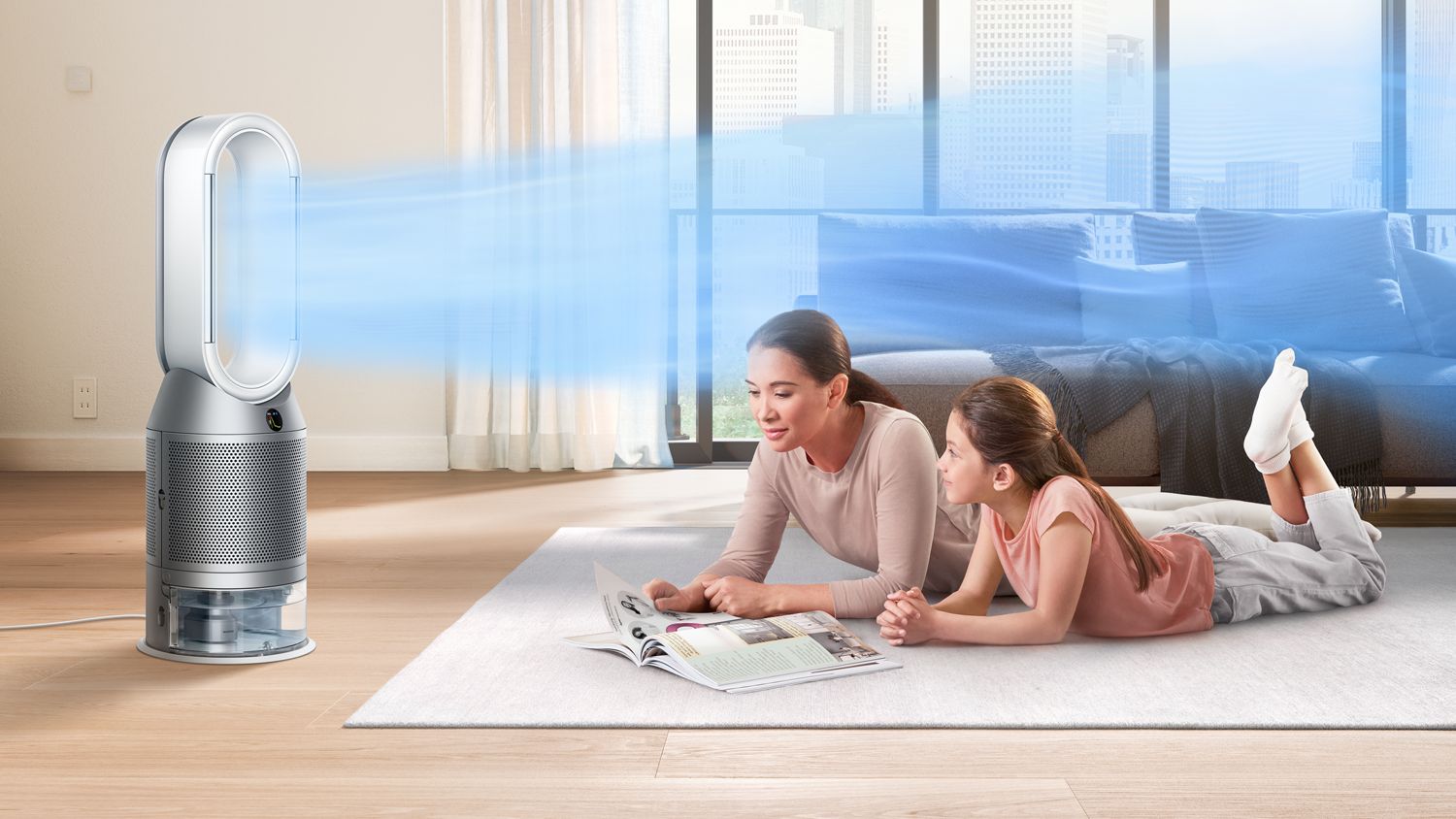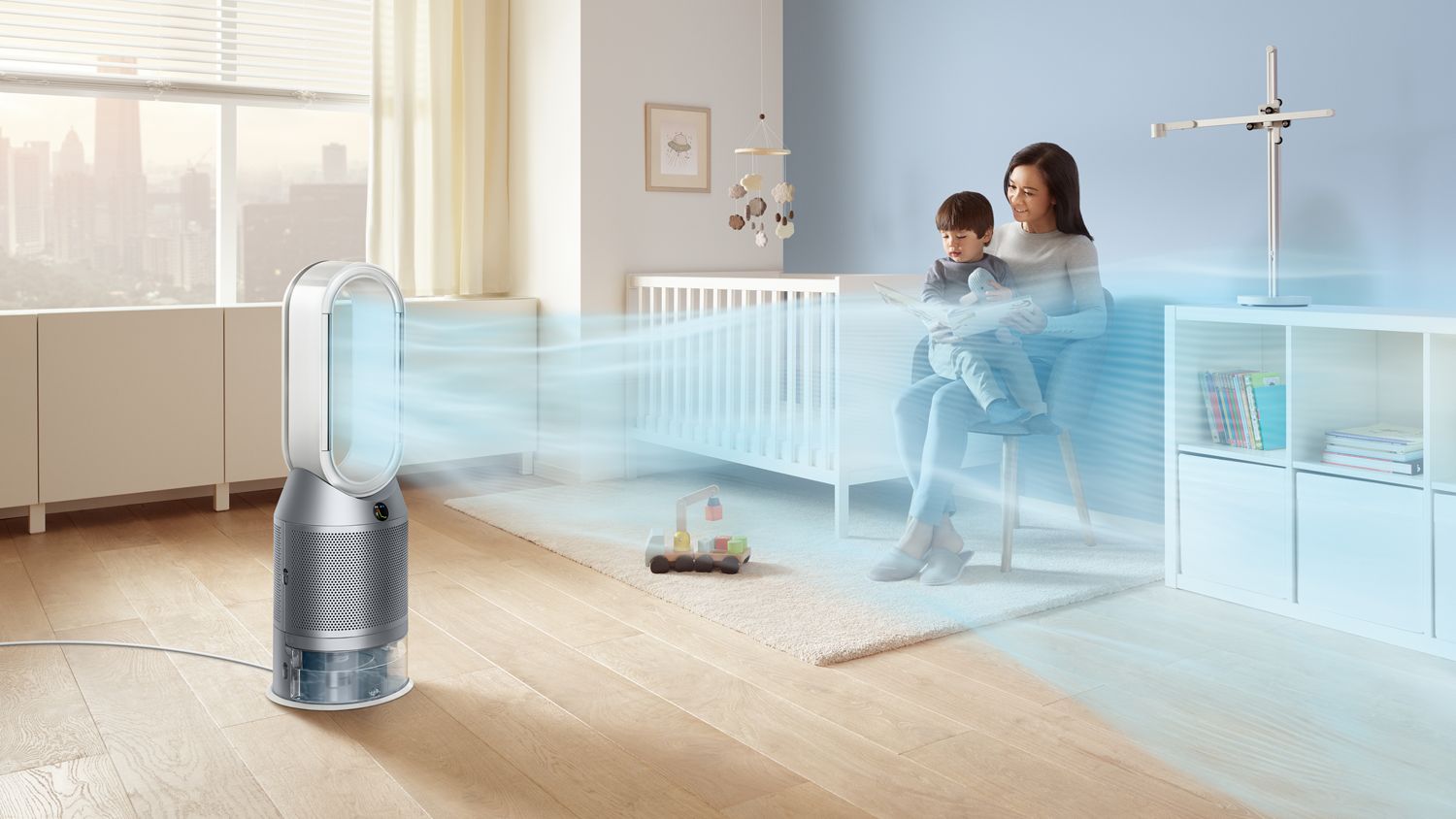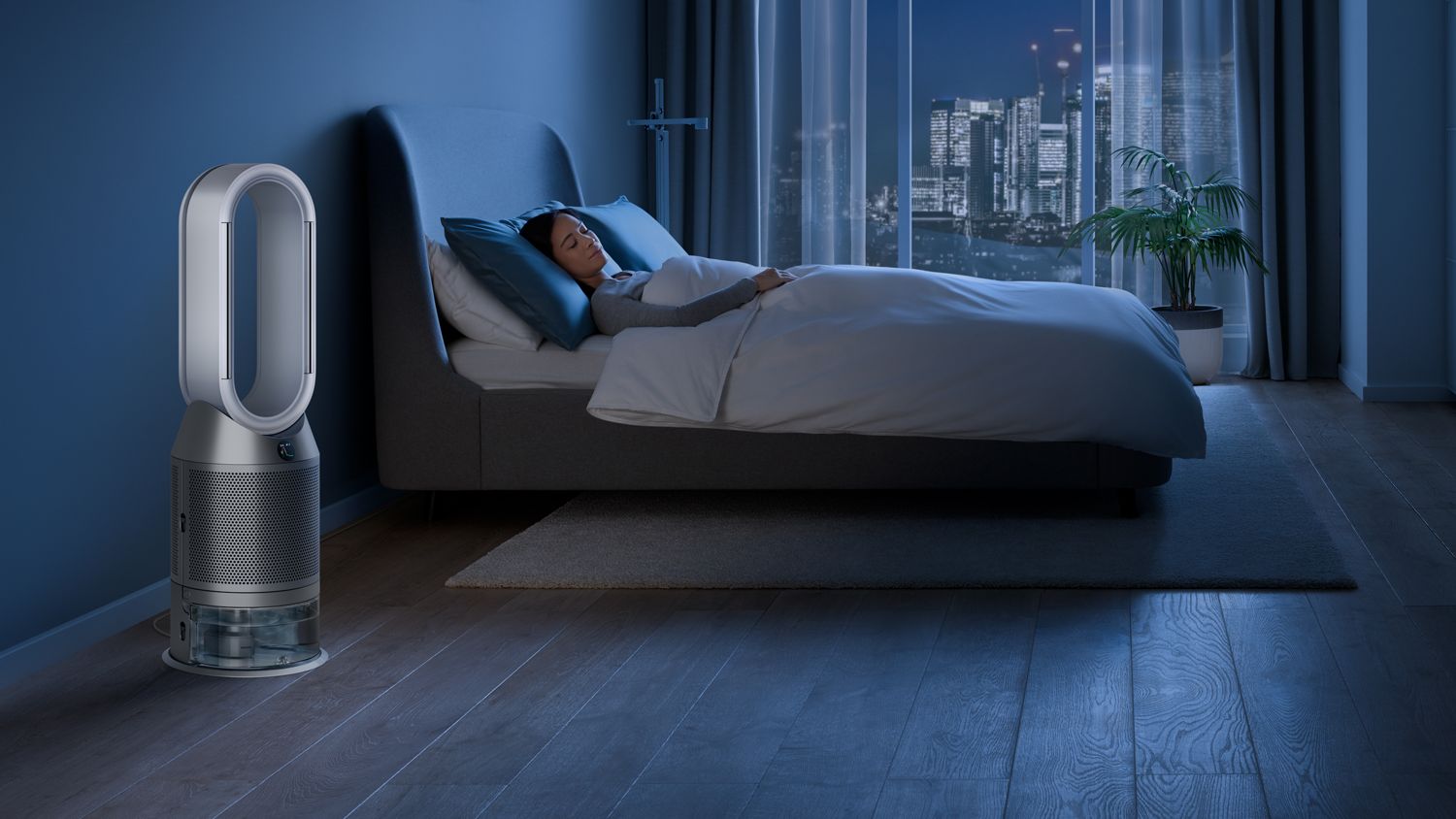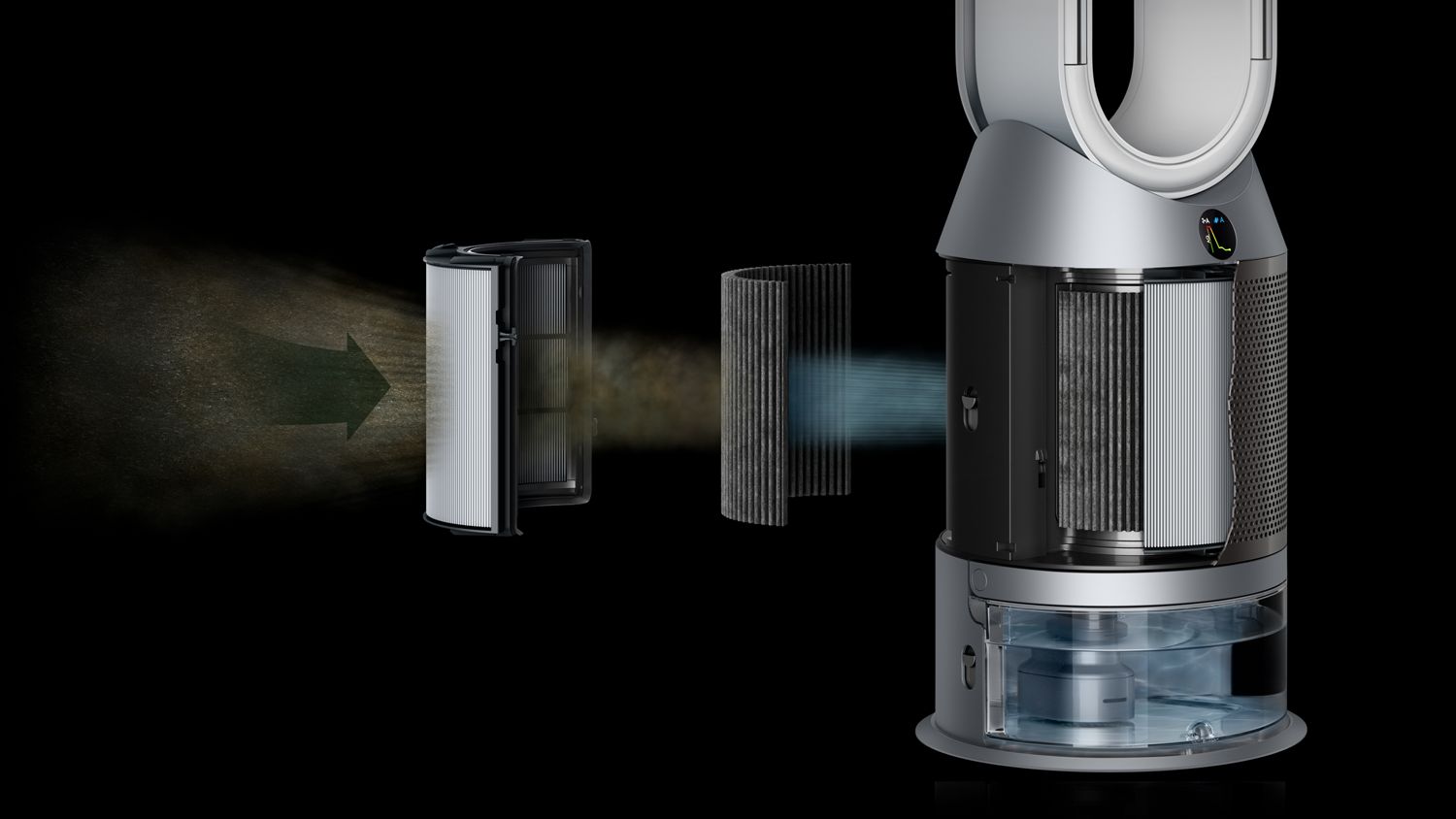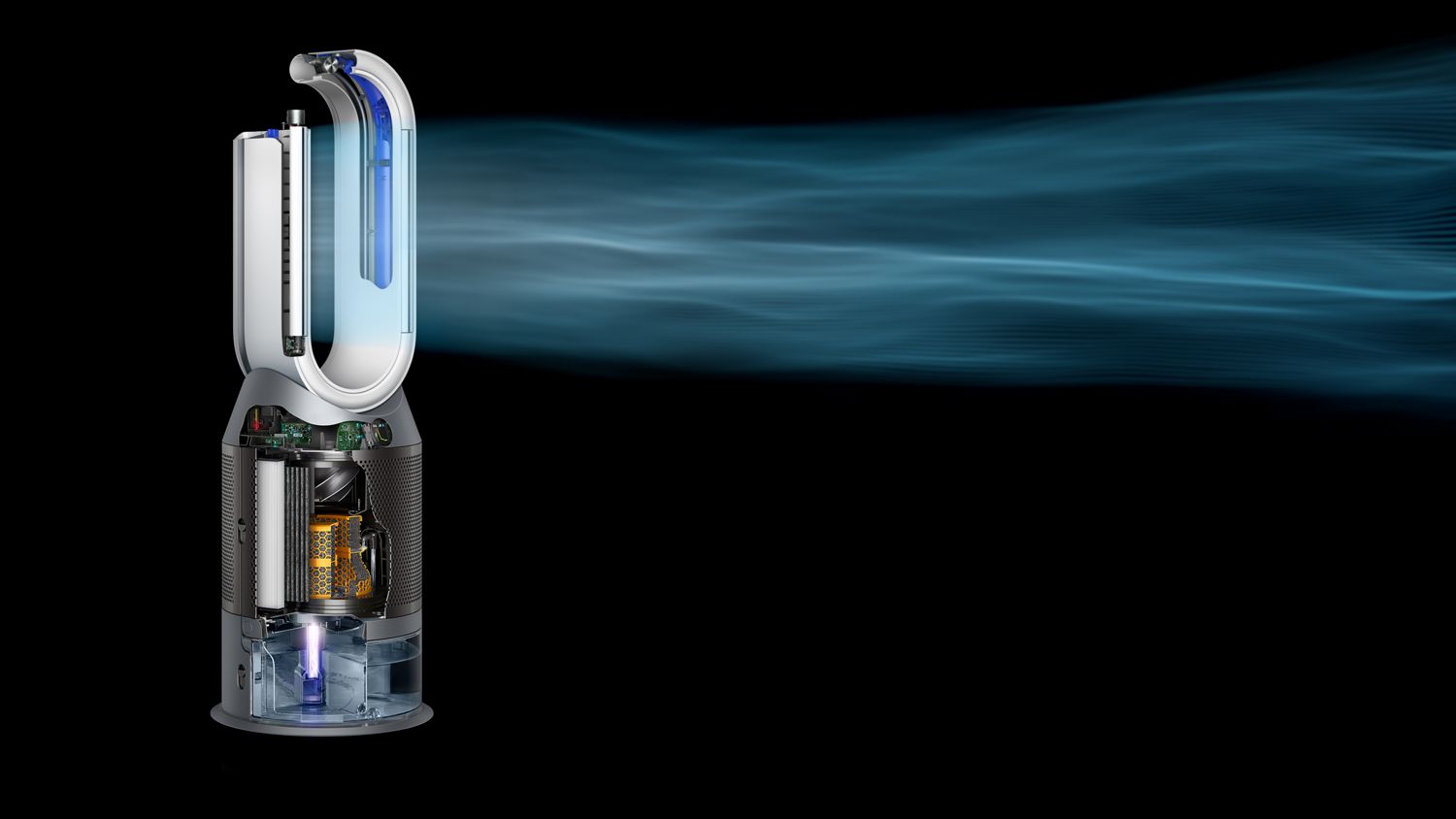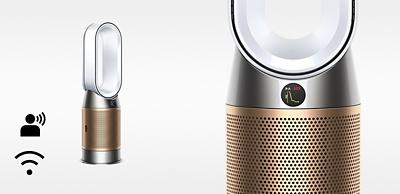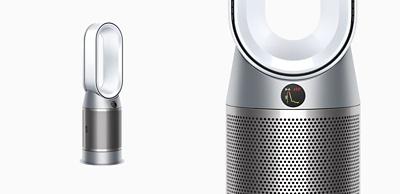A cleaner, more comfortable environment
The Dyson purifier humidifier is engineered to help improve your air quality. Its activated carbon filter removes gases and its HEPA H13 filter captures 99.95% of particles as small as 0.1 microns.³ Air Multiplier™ technology then projects purified, humidified air throughout the room² – cooling you when required.
*Dyson purifiers were challenged with airborne influenza A (H1N1 virus) and MS2 bacteriophage at an independent lab, using a 30 m3 chamber. After 60 minutes at maximum fan speed, the airbone concentration in the chamber was reduced up to 99.9%. Real-life may vary.
*Dyson purifiers were challenged with airborne SARS-CoV-2 (the virus that causes COVID-19) at an independent lab, using a 0.37 m3 chamber for 90 seconds. Dyson purifiers were also challenged with Phi-6 bacteriophage at an independent lab, using a 30 m3 chamber. After 90 minutes at maximum fan speed, the airbone concentration in the chamber was reduced up to 99.9%. Real-life may vary.
*During use. Tested in an external laboratory.
Specifications
-
Product diameter (skirt)
312 mm
-
Product diameter (shrouds)
280 mm
-
Weight
8.05 kg
/PH3A_variant-spec-WHSILNK.jpg?$responsive$&fmt=png-alpha)
-
Height
923 mm
Reviews powered by Bazaarvoice
Dyson Purifier Humidify+Cool™ PH3A Autoreact (White/Silver)
Overall rating
Features
Circulates purified humidified air
Dyson Air Multiplier™ technology mixes and circulates purified, humidified air throughout the room.
Cools you
In warmer weather, a powerful stream of purified, humidified airflow can cool you down.
Auto mode
Constantly monitors your air quality, automatically adjusting airflow to reach and maintain the most comfortable humidity level.
Continuous humidification
An efficient water management system and a one gallon tank give you up to 36 hours* of hygienic humidification without regular refilling.
Breeze mode
Unique algorithms vary the airflow to mimic a cooling, refreshing breeze.
Simple filter changes
Built-in reminders show you when your combination filter needs changing. It's quick and easy to do.
Night mode
For lighter sleepers. Monitors and purifies using the quietest settings, along with a dimmed display.
Jet Axis control
Two oscillators guide the airflow – projecting separately, or in unison, so you can choose different airflow modes.
Diffused mode
Diverts airflow through the back of the machine. To purify and humidify, without cooling you.
Deep clean cycle
Activate the machine's monthly hassle-free Deep clean cycle at the touch of a button. It will guide you through the simple step-by-step process.
Technology
Senses and reports, automatically
Three sensors constantly monitor your air – diagnosing pollutants at a molecular level and displaying live air quality in real-time reports.
Captures gases and ultrafine particles
Captures 99.95% of particles as small as 0.1 microns.³ Combined with activated carbon, it also removes odours and gases including VOCs.⁶
Destroys potentially harmful bacteria
Dyson Ultraviolet Cleanse technology exposes every drop of water to a powerful λ275nm UV light, to hygienically humidify.
-
Fully sealed to HEPA H13 standard⁵
To prevent pollutants leaking back into the air, it's not just the filter that's sealed to HEPA H13 standard, it's the whole purifier humidifer.⁵
-
Frequently asked questions
We've re-engineered our latest purifier humidifier to be fully sealed to HEPA H13 standard.⁵ With a hassle-free Deep clean cycle that eliminates mineral build-up throughout your machine's water system.
Your Dyson Pure Humidify+Cool™ is engineered to purify and humidify single rooms, so you should use it where you spend the majority of your time at home. When placing the machine, make sure there's at least a few feet of clearance on all sides, so that the air can circulate effectively. Close doors and windows and place away from air vents.
Yes. The machine works as a purifier humidifier, or just a purifying fan.
This depends on the water hardness where you live. The machine prompts you to run the cycle once a month in hard water areas. It prompts you less often in softer water areas. Running a Deep clean cycle helps to eliminate odours that occur through poor maintenance.
Glossary
-
Allergens
An allergen is a substance that can cause an allergic reaction by triggering the body’s immune system. Common indoor allergens include dust mite droppings, pet dander, mould and pollen.
-
Aspergillus mould
A common name for a visible group of fungi, mould thrives wherever there is dampness – sending out millions of spores into the air. Exposure to mould occurs via inhalation, skin contact or ingestion.
-
Bacteria
Microscopic, single-celled organisms that exist in their millions, in every environment. Not all bacteria are harmful, but some can have adverse effects, such as E. coli.
-
Benzene
Benzene is colourless, flammable liquid produced by both natural and man-made processes. It’s a natural part of crude oil, gasoline, and cigarette smoke. Indoors, it comes from products such as glues, paints, furniture wax, and detergents.
-
Carbon dioxide (CO₂)
A colourless greenhouse gas, which comes from the extraction and burning of fossil fuels. Increased CO₂ levels can impact cognitive function.
-
Dust mites
House dust mites are tiny insects that commonly live in household dust. They are one of the biggest causes of allergies. Each gram of house dust contains approximately 1000 dust mites.
-
Formaldehyde (HCHO)
Formaldehyde is often associated with the familiar smell of fresh paint, or the unboxing of new furniture. It's a colourless, flammable and potentially harmful gas used in some building materials and household products. Sources can include fabrics found in flooring and furniture, glues, paints, varnishes, air fresheners, and household cleaners.
-
H1N1 virus
This subtype of Influenza A virus, also known as swine flu, caused a global flu outbreak. H1N1 produces respiratory infectious diseases in humans and pigs. Symptoms can be similar to seasonal flu.
-
HEPA
HEPA (High Efficiency Particulate Air) is an air filter efficiency standard and a measure of a filter’s performance. For an air filter to be classified as HEPA, it must be capable of removing at least 99.95% (ISO, European Standard) or 99.97% (ASME, U.S. DOE) of particles whose diameter is equal to 0.3 microns.
-
HEPA 13
HEPA H13 is an even higher tier of HEPA air filtration efficiency. To meet HEPA H13 standards, a filter must be able to remove 99.95% (ISO, European Standard) or 99.97% (ASME, U.S. DOE) of microscopic particles at the most penetrating particle size of 0.1 microns.
-
Humidification
A process of increasing air moisture content through the addition of water vapour or steam. Humidifiers can add moisture to the air in dry conditions, creating a more comfortable indoor environment.
-
Micron
Airborne particles are usually described in microns. One micron is equal to one-thousandth of a mm. The human eye struggles to see anything smaller than 25 microns in size. Allergens are microscopic. The size of dust mite allergens, mould spores and other insect allergens is often between 0.5 to 5 microns. To provide context, the diameter of a human hair is around 50 microns.
-
Nitrogen dioxide (NO₂)
Nitrogen dioxide is a liquid below 21.2 °C and a gas at higher temperatures. It is toxic to humans in both states. Gas stoves and space heaters are the most common indoor sources of NO₂ emissions. Other sources include improperly vented furnaces and water heaters.
-
Pet dander
Pet dander is made up of tiny particles of skin, saliva and urine, shed by animals with fur or feathers. Pet dander lingers in the air before settling on surfaces such as furniture, bedding, and fabrics. Exposure to these airborne particles can trigger allergies.
-
Particulate matter (PM)
PM stands for particulate matter, which consists of microscopic solid or liquid particles and pollutants. PM is often followed by a number, which represents the size of the particulate matter in microns (a micron is one-thousandth of a mm). For example, PM01 means particulate matter that is 0.1 of a micron in size. PM2.5 equals particles that are 2.5 microns in size, and PM10 means particles up to 10 microns in size. Indoor PM can be generated through many day-to-day activities, including cooking, cleaning and the burning of candles and fires.
-
Pollen
Pollen is a powdery substance released from seed plants as part of their reproduction process. It typically appears from trees in the spring, grasses in the summer, and weeds in the autumn. Pollen grains are among the most common allergens.
-
Purification
The process of making something free of any contaminants or physical impurities. Air purification is designed to filter the air in your home – removing pollutants such as dust, allergens and viruses.
-
Selective Catalytic Oxidisation (SCO)
SCO is an abbreviation for Dyson's Selective Catalytic Oxidisation filter, a specific type of filter engineered to capture and destroy formaldehyde at the molecular level. Dyson SCO filters break the pollutant down into tiny amounts of water and CO₂. Our filter then naturally regenerates from the oxygen in the air, so it can keep destroying formaldehyde continuously, without ever needing to be replaced.
-
Volatile organic compounds (VOCs)
Volatile organic compounds are potentially harmful gases found in many household products. Common sources include paints, varnishes, air fresheners, cosmetics, and cleaning products.
/PH3A_Humidity_Education_Image.jpg?$responsive$)
Helpful tips about humidifying your air
Dyson purifier humidifiers let you achieve your desired humidity either automatically or manually. In Auto mode, just set it and forget it. In manual mode, the LCD indicates if you need to increase airflow – which may help you reach your target quicker. And remember, keeping your machine away from drafts and turning down your home’s heating or AC units can also improve performance.


